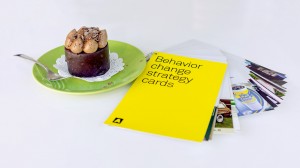 The next time you’re planning a behavior change project, take a look at Artefact’s behavior change strategy cards. They can help you brainstorm new ideas.
The next time you’re planning a behavior change project, take a look at Artefact’s behavior change strategy cards. They can help you brainstorm new ideas.
The set of 23 cards was created as a way to take insights from fields like behavioral economics and cognitive psychology and help make them practical tools. They’re attractive, with not too many words, making them easy to use.
I’ve been working on changing people’s environmental behavior for many years. But I found that the cards gave me some new insights and things to try.
The cards are divided into five sections:
- Make it personal: The persuasive power of “me” and “my” (cards 1– 6)
- Tip the scales: How perceptions of losses and gains influence our choices (cards 7– 13)
- Craft the journey: Why the entire experience matters (cards 14 – 17)
- Set up the options: Setting the stage for the desired decision (cards 18 – 21)
- Keep it simple: Avoiding undesirable outcomes (cards 22 – 23)
For example, here’s part of card #3:
Get the user to make an argument for the desired outcome.
People are more likely to agree with persuasive arguments when they’re forced to actively make the argument themselves.
- How might we help users role-play the opposing viewpoint?
- How might we get users to communicate the logic behind the desired behavior to someone else?
- How might we encourage users to advocate for another position?”
Each card also includes an example. On card #3 it says:
Persuading others to quit. In one experiment people were asked to act like they were convincing a friend to stop smoking. Participants either role-played the persuader or the friend. Those who played persuaders, and actively argued against smoking, were more likely to change their own attitudes about smoking as a result.”
You can download the whole set of cards here.
Thanks to Laurie Foster for sharing this resource.